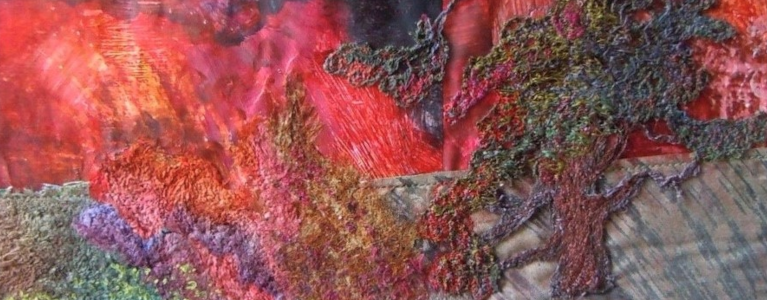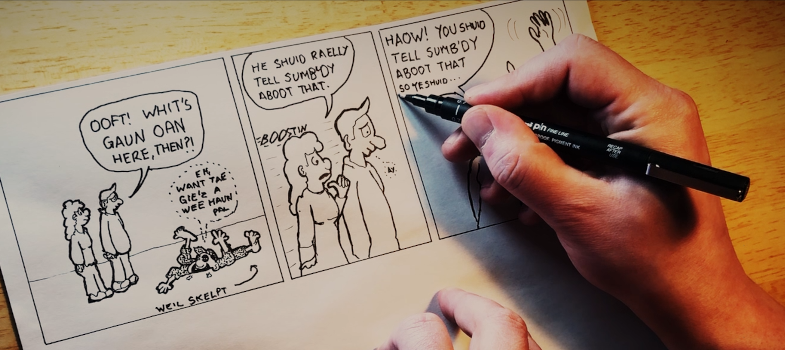Scots Language, Creativity and the Expressive Arts

© Gerda Stevenson
In this section Stevenson outlines some creative developments – tangible links between art forms – which have occurred as a result of the publication of Quines.
Activity 4
Work through Stevenson's text in this section, where she explores the various themes of her poetry collection Quines.
Take notes on aspects interesting and relevant to you and your pupils as you go along.
Again, takes some notes on ideas for teaching activities that derive from what you are reading in this section.
In March 2020, an exhibition was mounted by EDGE: Textile Artists Scotland at Edinburgh’s Central Library: 38 textile panels were created, inspired by Quines, each poem displayed next to its relevant panel in display cases on various floors of the library.
It was fascinating and exhilarating
to see the range of visual responses to the poems, and also the wide
spectrum of materials used. Some are three dimensional structures
which could be viewed in the display cases from various angles, while
others, created from thousands of miniature stitches, are mounted,
like pictures, on the walls. Collage techniques are also employed,
incorporating actual words and whole lines from the poems. There are
abstract works, as well as figurative:
Another artistic response to Quines
came from the Scottish
artist Helen Flockhart, who painted her hauntingly beautiful work
Lover’s Eye, after
hearing me read my poem The
Abdication of Mary Queen of Scots on
BBC Radio 4’s Woman’s Hour.
Helen included this
painting in her exhibition Linger
Awhile, inspired by the
life of Mary Queen of Scots, and published my poem in the catalogue.
In turn, she gave permission for her painting to be the cover image
for the second edition of Quines
– a satisfying and
comradely artistic exchange:
If you look carefully, you can see,
on the woman’s dress, a repeated image in pink tones depicting the
island where Lochleven Castle stands (where Mary Queen of Scots was
imprisoned and forced to abdicate), and the figure of a woman pushing
a small rowing boat with two babies in it – Mary dreaming, perhaps,
of escaping with her still-born babies – or maybe in her dream they
are still alive? It’s a haunting image. Both the island of
Lochleven and the miniature boat are shaped like eyes. The hills and
cloud above the castle are eye-shaped too, with a sun, or perhaps
it’s a moon, like an iris or pupil at the centre. And the woman in
the painting (who could be Mary Queen of Scots, or could be the
artist herself?) is also holding an eye on a chain.
On the following link you can watch
a short interview with Helen Flockhart in her Glasgow studio, where
she talks about responding to other art forms as starting points for
her
paintings:
Arusha - Linger awhile, Helen Flockhart
Another poem from Quines
– Demerara – about
Eliza Junor (the daughter of plantation owner Hugh Junor and an
unknown slave woman) was the starting point of a blog by novelist Vee
Walker. Since reading the poem, Vee has researched Eliza’s life,
including the various places she lived – Demerara, on the north
coast of South America, where she was born, moving to Fortrose in the
Scottish Highlands with her father and brother, tracing her journey
to Brixton in London, and finally back to Fortrose. In this detailed
and probing blog, the author poses many tantalising questions about
Eliza’s life, and one can see the building blocks of a potential
novel:
